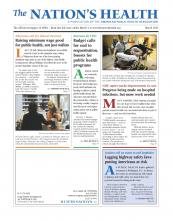Most Americans entering a hospital for care hope to leave healthier than when they arrived. But in some cases, hospital patients acquire health care-associated infections as part of their stay — and even die from them.
In 2011, there were 722,000 health care-associated infections — such as Clostridium difficile or methicillin-resistant Staphylococcus aureus — in U.S. acute care hospitals and 75,000 related deaths, according to the Centers for Disease Control and Prevention. The problem is critical enough that federal health officials have set national goals and created an action plan for reducing them.

A child with a broken leg is brought into a hospital in Miramar, Florida, in 2011. Hospitals are working to ensure that patients do not acquire infections during their stay, with progress being made.
Photo by Juanmonino, courtesy iStockphoto
Officials believe those targets can be reached: CDC has named reducing health care-associated infections as one of its “seven winnable battles,” which are public health priorities with large-scale impact on health and that have effective strategies to address them.
A new federal report tracking progress on such infections shows that U.S. acute care hospitals have made some improvements in preventing certain health care-associated infections, but still fall short of goals.
The “National and State Healthcare-Associated Infections Progress Report,” released Jan. 14 by CDC, shows nationwide and state progress — including the District of Columbia — in preventing and reducing health care-associated infections in 2013.
The report tracked health care-associated infections most commonly reported nationwide to CDC: central line-associated bloodstream infections, catheter-associated urinary tract infections, hospital-onset C. difficile infections, hospital-onset MRSA and surgical site infections related to 10 procedures. For state-specific data, surgical site infections were tracked for only abdominal hysterectomies and colon surgery — the two most reported surgeries, CDC said.
Overall, 26 states had reduced infections better than the national average for at least two different types of infections. Nineteen states performed worse than the national average on at least two, the report said.
Approximately one in 25 patients is at risk for at least one health care-associated infection during a hospital stay, but rates of certain health care-associated infections can decrease by more than 70 percent if hospital staff develops plans of action, the report stated.
“Full engagement between local, state and federal public health agencies and their partners in the health care sector will be vital to sustaining and extending HAI surveillance and prevention progress,” the report stated.
Infection data came from CDC’s National Healthcare Safety Network, which tracks health care associated-infections from more than 14,500 health care facilities and hospitals. Infection rates were measured by a standardized infection ratio — a number that can be used to chart infection progress.
For specific infections, data show big improvements in preventing central line-associated bloodstream infections and surgical site infections. From 2008 to 2013, there was a 46 percent decrease in central line-associated bloodstream infections. There was a 19 percent decrease in surgical site infections across 10 procedures during that same time period, and an 8 percent decrease in MRSA bloodstream infections between 2011 and 2013.
But despite the improvements, there are also setbacks. There was a 6 percent increase in catheter-associated urinary tract infections. Of the 19 states that performed worse than the national average on at least two infections, eight states were worse on at least three, the report said.
Overall, the report shows U.S. hospitals missed the mark on reaching infection reduction goals set out in a 2009 national plan.
While the national decrease in central line-associated bloodstream infections was promising, the goal was to reach 50 percent by 2013. Additionally, the goal was to reduce surgical site infections by 25 percent by 2013, but hospitals reported a 19 percent decrease.
“It’s important to note there are improvements,” said Lisa McGiffert, director of Consumers Union’s Safe Patient Project. “But there are still hundreds of thousands of people getting infected in hospitals every year.”
McGiffert said she suspects that when 2014 data comes out, there will be further improvements in central line- and catheter-associated urinary tract infections because reductions in those are tied to financial penalties hospitals incur for high rates.
“Every time these reports come out, Congress should be outraged,” she told The Nation’s Health. “You have to have that outrage in order to get the resources and accountability that comes with that.”

A new report found a decrease in surgical site infections related to 10 procedures, such as colon surgery, in acute care hospitals.
Photo by Trish233, courtesy iStockphoto
States show progress on cutting infections
A number of states are taking the lead on reducing health care-associated infections and serve as examples. Illinois was one of six states that outperformed the national average for at least four types of infections, including catheter-associated urinary tract infections.
Organizations such as the Illinois Hospital Association and the University HealthSystem Consortium have been instrumental in corralling state hospitals to share their infection rate data and their successes and failures via tools such as webinars, said Jodi Joyce, RN, MBA, FACHE, associate vice president for quality and patient safety at the University of Illinois Hospital and Health Sciences System.
Emails are sent to everyone in the University of Illinois Hospital and Health Sciences System, including the board of trustees, nurses and doctors, to report how many infections occurred in the last month, what staff is doing to prevent future infections and if they are meeting goals to reduce infections.
Since Joyce began working for University of Illinois Hospital and Health Sciences System in 2012, there has been a 70 percent improvement in preventing both bloodstream and urinary tract infections among its patients, she said.
“We’ve found it’s largely about how (hospital) leaders are paying attention to this and how we’re providing support to our staff,” Joyce said.
In Arizona, which performed worse than the national average on three infections — central line-associated bloodstream infections, C. difficile infections and surgical site infections for both abdominal hysterectomies and colon surgery — officials are working to improve.
Kara Snyder, RN, MS, CCRN, CCNS, director of quality at the University of Arizona Medical Center, said Arizona hospitals have been early adopters of infection prevention, but that it is no longer good enough to improve incrementally if hospitals statewide want to reach benchmarks in preventing infections.
Because C. difficile is often linked to overuse of antibiotics, Snyder said the medical center’s strategy is to engage a team of infection prevention and disease specialists and pharmacists to be “good stewards” of antibiotics.
“The landscape 10 years ago was generally that ‘infections happen,’” Snyder said. “Now the landscape is that they can never happen. It’s a big swing and it’s a very exciting time to see this kind of improvement for our patients, even though Arizona didn’t make the strides we wanted.”
For the full report, visit www.cdc.gov/hai/progress-report.
- Copyright The Nation’s Health, American Public Health Association









